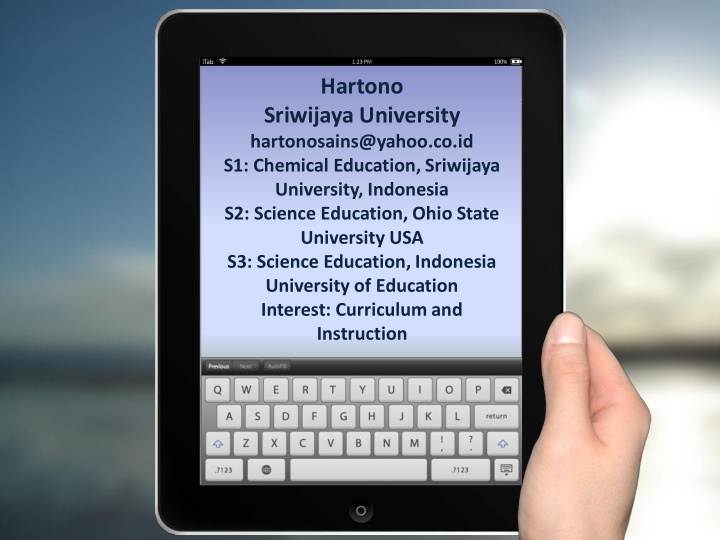



Hartono Sriwijaya University hartonosains@yahoo.co.id S1: Chemical Education, Sriwijaya University, Indonesia S2: Science Education, Ohio State University USA S3: Science Education, Indonesia University of Education Interest: Curriculum and Instruction
Indonesian Higher Education Learning Reform: Designing a model of Scientific Learning in Faculty of Teacher Training and Education Seminar on International Confereence on Education, Kuala Lumpur, 20-22 April 2017
Implemented & Superior Introduction Learning Model of Process Learning Standard Higher Education Standards Scientific Mastery Learning Teacher Competencies Test
RESEARCH PROBLEMS 1 How scientific learning model is designed to increase the concept mastery of students in Faculty of Teacher Training and Education 2 How effective is the scientific learning model to increase the concept mastery for students in Faculty of Teacher Training and Education 3 What are the characteristics of scientific learning model In Which way does scientific learning model 4 differ from common practice in its implementation in Faculty of Teacher Training and Education
RESEARCH OBJECTIVES To know characteristic scientific learning model and in which ways they are differ To know effectivity of from common practice in scientific learning model implementation toward mastering concepts of To produce scientific learning students in Faculty of Teacher model that can be Training and Education implelemted in Faculty of Teacher Training and Education
LITERATURE REVIEW Organizing, 1. Confrontation Formulating, with the problem Explanation 2. Data Gathering- Analysis of Verification Learning process 3. Data Gathering- Experimentation 5 Scientific Learning Model (Modified from Inquiry Training Model, Joyce, 2011)
Model of Learning Academic Achievement Zulkardi et al. (2014) REVIEW Hartono (2011a) Shemwell, Chase, Schwartz Hartono (2011b) (2015) Hartono (2012) Saribas & Ceyhan (2015) Hartono & Rustaman (2009b) Joycce, Weil, Calhoun (2011) Hartono et al. (2009a) PREVIOUS RELATED STUDIES
HYPOTHESES There is no difference There is a difference among between two groups two groups Group A: Teaching with Group A: Teaching with Scientific Learning model Scientific Learning model Group B: Teaching without Group B: Teaching without Scientific Learning Model Scientific Learning Model
RESEARCH METHODOLOGY
RESEARCH SUBJECT SECOND STAGE SUBJECTS ARE STUDENTS FROM FOUR (S1) STUDY PROGRAMS SUCH AS: CHEMISTRY EDUCATION, PHYSICAL EDUCATION, MECHANICAL ENGENEERING EDUCATION, BIOLOGY EDUCATION (SRIWIJAYA AND LAMPUNG UNIVERSITY) THIRD STAGE SUBJECTS ARE STUDENTS FROM PHYSICAL EDUCATION ONLY (SRIWIJAYA UNIVERSITY) Subjects are two classes: an experimental group and control group.
DATA COLLECTION 3 Walkthrough 2 Test 1 Documentation
VALIDITY & RELIABILITY Reliability Test Items Content Validity (Anates) Model of Learning (Expert Review)
DATA ANALYSIS 1 3 2 Documents Test Hypotheses Analysis N-gain t-test anates SPSS
DATA ANALYSIS Independent Anates sample t-test SPSS 22.0
Practicality of Learning Model Physical 4.0 Education Chemitry 4.2 Education Mechanical Engeneering Education 4.0 Range of score: 1-5 Biology Education 4.1
MODEL OF SCIENTIFIC LEARNING https://www.youtube.com/watch?v=vk6fZ_i0nkk No Stages Lecturer Activities Students Activities 1 Problem Confrontation Show the contextual a problem Plan to make solution the problem Linguistic Logical Spatial Kinesthetic 2 Data Collection and Show possible variables that Verification possible Verification influent the problem variables and collect 42.65% 45.59% 38.23% 66.91% data that may relate to 3 Data Collection and Give directions toward planning Collect data and Experiment to collect data and give clues control the variables kinds of variables that enggage that influent results 4 Organization, formulation, Give direction in class Group presentation and explanation discussion 5 Learning Implementation Reflection Give respond toward Process Analysis learning process
MODEL OF SCIENTIFIC LEARNING IN IMPLEMENTATION CHEMISTRY BIOLOGY PHYSISCAL MECHANICAL EDUCATION EDUCATION EDUCATION ENGENEERING EDUCATION LESSON PLAN Animal Structure COUNTING OF PAINTING DESIGNER NUTRITIONAL VALUE Linguistic Logical Spatial Kinesthetic Collect data Collect data based Collect data based Collect data based 42.65% 45.59% 38.23% 66.91% based literature and verify literature and verify literature and verify literature and verify Collect data in Do mini experiment Collect data in software Do mini experiment field (schools) and collect data in lab and collect data in lab Make report Make report and Make report and Make report and and presentation presentation show the product of presentation painting and presentation Reflection Reflection Reflection Reflection
N-Gain in Percentage Physical 0.47 Education Chemistry 0.44 Education Mechanical Engeneering Education 0.27 Range of score : High: N-Gain > 0.7 Moderate: 0.3 ≤ N-Gain ≤ 0.7 Low: N-Gain < 0.3 Biology Education 0.52
Implemantation Program at Physical Education (Science of Nutrition) Equal Variances Equal Variances assumed not assumed F 2.136 Levene's Test for Equality of Sig. .149 Variances t-test for Equality of T -14.454 -14.508 Means Df 61 58.708 Sig. (2-tailed) .000 .000
DISCUSSION Findings Why could they occur? Weaknesses • Instruments • Researcher • Participants Previous Studies • Support
CONCLUSION AND RECOMMENDATION
CONCLUSION • Designing of scientific learning model used modified Dick and Carey Model as (1) program design and development, (2) program try out and revision, and (3) program implementation. Syntax of the scientific learning model, as follows(1) problem confrontation, (2) data collectionand verification, (3) data collection and experiment, (4) organization, formulation, and explanation,(5) learning implementation process analysis
CONCLUSION • Average of N-Gain from 4 study programs is 0.42 (moderate) • There is a difference of learning outcomes between two group alpha 1% sig (2-tailed) = 0.000 < 0.01.
RECOMMENDATION • Recommendation for Future research: Student responsibility in completing their study tasks Implementation the model in other course and study programs
Recommend
More recommend